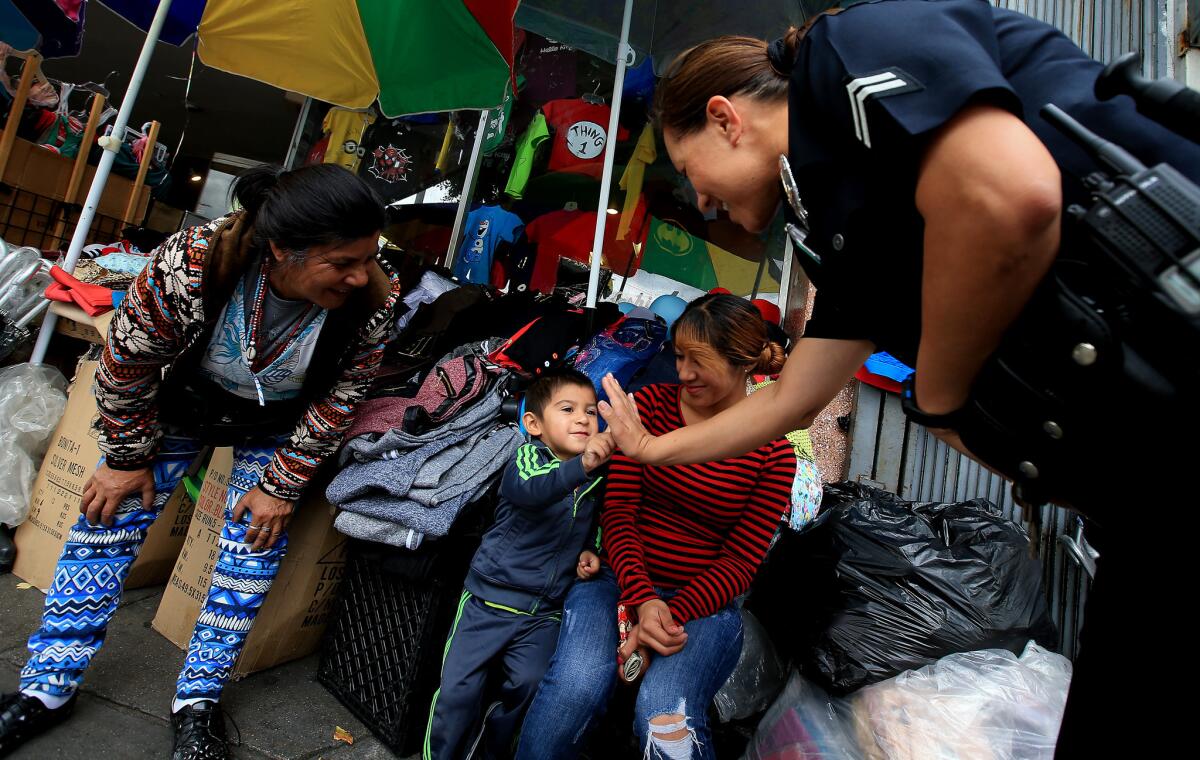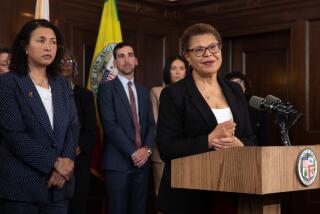More LAPD cops to ditch cars and walk the beat in Eastside areas

LAPD Officer Norma Perez talks with vendors as she walks a “foot beat” along Cesar Chavez Avenue in Boyle Heights.
There was a time when the two Los Angeles police officers would have cruised down Cesar Chavez Avenue in a black-and-white, scanning the sidewalks from their patrol car as they passed through Boyle Heights.
But on a recent morning, Officer Eric Perez and his partner spent their patrol time strolling past vendors selling brightly colored jeans and umbrellas, calling out to store owners they recognized and sauntering into shops with a cheerful “Buenos dias!”
The pair ducked into a bakery to talk to a man who had complained about people stealing from his shelves, then checked in with another store about taggers marking an outside wall with graffiti. They urged a young mother to enroll her 3-year-old son in preschool and helped push a broken-down Nissan up the street. And when a bank employee flagged the officers down to show them a picture of his missing Siberian husky, they promised to keep an eye out.
The two officers are part of a renewed effort to get police out of their cruisers and walking the streets to build deeper connections within the communities.
On Monday, the Los Angeles Police Department doubled the number of foot patrols in its Hollenbeck division, which covers Eastside communities such as Boyle Heights and El Sereno. Sixteen officers will be assigned to eight areas, some only about a quarter-mile.
If the effort goes well, officials said, they will look for ways to expand “foot beats” across the city.
It’s a back-to-basics approach that is common in other cities that are more compact, like Chicago, or that have larger departments, like New York, but it never became a staple of policing in Los Angeles, where officers rely on patrol cars to cover the city’s roughly 470 square miles.
“We have foot beats that come and go and foot beats that work some areas, but none that will be like in Hollenbeck,” said Assistant Chief Jorge Villegas. “One hundred percent of the time, that’s all they’ll do.”
The move marks a step away from the iconic image of LAPD officers cruising down palm-lined streets in black-and-white cars. Department officials and veterans said the car patrols are essential to police a vast city, but can keep officers at a distance from the public.
The idea of encouraging officers to get out of their patrol cars dates back decades. In 1991, after the beating of Rodney King, the Christopher Commission report noted that advocates of community policing recommended that officers spend less time inside their vehicles talking to each other and more time on the streets talking to residents.
The areas where foot beat officers are assigned are small, LAPD officials said, but police can have a significant effect because business owners and residents will come to see them as familiar faces.
“They feel more comfortable,” said Perez during his recent patrol on foot along Cesar Chavez Avenue. “They know that we’re there today and we’re going to be there tomorrow and we’ll be there the next day.”
Like the other officers working the foot beats, Perez and his partner, Officer Norma Perez, were hand-picked for their assignment. (The two aren’t related, but have been asked by community members if they are married.) The veteran officers — Eric Perez has been with the LAPD for nine years, Norma Perez for nearly eight – have walked an 11-block stretch of Cesar Chavez Avenue since last fall.
They’ve dealt largely with quality-of-life issues: illegal vending, graffiti, minor thefts from stores. Those who work in the area said they’ve noticed a difference since the officers began walking the beat. The sidewalks are no longer choked by vendors hawking goods and trouble-makers have stopped lingering outside the store fronts. The area feels safer, they said.
“It’s been wonderful. You can see it’s a big change,” said Angel Villegas, whose wife owns a vehicle registration shop along Cesar Chavez Avenue. Villegas said the officers told them how to report graffiti on their building walls, and stop by frequently to check in.
“She always comes by and checks up on my wife,” Villegas said, gesturing to Norma Perez. “And I thank you for that.”
The officers have drawn their guns just once while working the foot beat, Eric Perez said, when they detained two gang members who were fighting. The gangsters didn’t cooperate when the officers approached, he said, and made worrisome movements toward their waistbands. The officers had the men lie prone on the ground to search them, but let them go after finding only a flashlight.
“In seven months, that’s not bad at all,” Eric Perez said about drawing his gun. “Most guys take them out every day.”
Capt. Martin Baeza, who oversees Hollenbeck, said a few of the foot beats in his division date back several years but that officers assigned to those patrols often spent half their time in their cars. Residents and business owners told him how much they liked the foot patrols and said they wanted more, Baeza said.
When the LAPD shuffled its top brass this year, his new boss was supportive of adding more foot beat areas and assigning officers to walk them exclusively, he said.
Baeza said the eight foot beats covered areas where police felt officers could have the greatest effect. In selecting the locations, he said, officers spoke to community members, conducted a crime analysis and looked at the number of businesses in each area.
For example, he said, Mariachi Plaza was selected because of the number of events hosted at the Eastside landmark. “We want to make sure that they’re policed well and we have a presence,” he said.
Like many departments across the country, the LAPD has long emphasized the importance of community-based policing. The foot beats, officials say, signal an effort to take that philosophy to the next level.
“I want the officers to be known by their name,” Baeza said. “I want the officers to know the [residents] by their names so that we have an established relationship with the community where they have that comfort level to share the good issues … as well as some of the issues that need to be addressed.”
And given the national conversation about strained relations between police and communities, Baeza said, “the timing here is right.”
Back on Cesar Chavez Avenue, Norma Perez stopped to talk to the man with the broken-down car. Her partner stood on the corner and shook hands with a norteño musician, one of several who hang out on a nearby bench waiting for someone to hire them to play. The saxophone-carrying man smiled at the officer and gave him a thumbs-up.
As the two officers continued their walk down the avenue, the man crossed the street. He stood motionless on a corner, 10 feet from a black-and-white police car stopped at a light. Neither the man nor the officer inside acknowledged each other.
When the light changed, the man stayed at the corner. The police car drove away.
Follow @katemather for more LAPD news.
More to Read
Start your day right
Sign up for Essential California for news, features and recommendations from the L.A. Times and beyond in your inbox six days a week.
You may occasionally receive promotional content from the Los Angeles Times.







